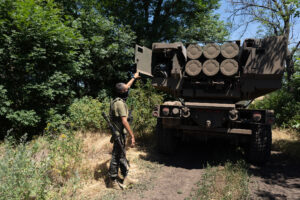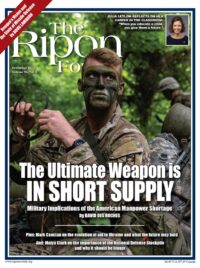
What began as a trickle is now a rushing torrent. Military aid to Ukraine that began in 2014 in reaction to the Russian takeover of Crimea has surged to $80 million a day. That aid has gone through six phases, each with distinct features that tell us something about the nature of the war and the U.S. response.
Before considering the different phases, though, it’s worthwhile considering the whole. Congress has appropriated $68 billion for aid to Ukraine — about 60 percent for military activities and 40 percent for humanitarian relief and economic support. The military element has two parts. One part ($11 billion) strengthens the U.S. defense industrial base and supports U.S. forces that deployed to Europe to reassure allies. The larger part ($27 billion) consists of military aid to Ukraine — about $17 billion that will be delivered immediately and another $10 billion over several years.
NATO and other countries have committed a total of about $41.4 billion. The United Kingdom and Poland provide substantial military aid. The European Union and Canada provide relatively more financial and humanitarian aid. Some countries, like Poland and the Baltic nations, provide a high level of aid compared to their economies (up to 1 percent). Others, like France and Germany, lag.
Congress has appropriated $68 billion for aid to Ukraine … NATO and other countries have committed a total of about $41.4 billion.
Phase 1: Prewar. Military aid to Ukraine began in 2014. That spring marked a major disruption for the Obama national security team. The relatively benign national security environment they envisioned had been shattered by Russia’s takeover of Crimea, ISIS’s sweep out of the desert, and China’s continuing assertiveness in the South China Sea. The Obama Administration began providing non-lethal aid to strengthen Ukraine, eventually reaching about $300 million per year. The Trump Administration continued that but included lethal aid like antitank weapons. Trump infamously also tried to use this aid as a political lever against the Biden family.
Phase 2: The early crisis (February-April). The invasion did not catch Ukraine totally unprepared since it had been fighting Russia and Russian surrogates in the Donbas since 2014. However, it was not prepared for the scale of the military effort. Thousands of Ukrainians joined newly created territorial defense units, but they needed equipment. The United States and the West provided lots of the basics like radios, medical supplies, and protective gear. They also sent weapons that were easy to use, like infantry antitank and antiaircraft missiles. One of these weapons, Javelin, became the iconic weapon of the early war period with songs and illustrations (e.g., St. Javelin).
The purpose was to stave off defeat, and that was successful. Militaries in combat need a continuous flow of ammunition and weapons. Without the rapid delivery of weapons and munitions from the United States, NATO, and others, Ukraine would have been overwhelmed in two or three weeks.

Phase 3: Scrounging up Soviet-era equipment (April-June but continuing). The prewar Ukrainian army used Soviet-era equipment almost exclusively. Rather than lose time trying to introduce new equipment, the United States and Europe sent more of this Soviet-era equipment and supplies. U.S. procurement teams searched the globe for any country willing to sell its old Soviet equipment. The greatest need was artillery ammunition, which units in combat use in huge quantities; for example, an artillery battery uses as much ammunition in a week of combat as it does in a year of peacetime training.
Former Warsaw Pact members in Eastern Europe were particularly anxious to dispose of their Soviet-era equipment so they could get more modern, NATO-standard equipment. It was a win-win-win: the Ukrainians got equipment they were accustomed to using, the Eastern Europeans could upgrade their inventories, and defense contractors sold more weapons.
Without the rapid delivery of weapons and munitions from the United States, NATO, and others, Ukraine would have been overwhelmed in two or three weeks.
Phase 4: The introduction of NATO equipment (May to present). Eventually, Soviet-era equipment and ammunition became hard to obtain since the world market was limited, and Russia and China, the principal suppliers, were unavailable. The shortage of artillery ammunition became a crisis. This drove the U.S. and NATO to begin supplying their own systems. For artillery, the French sent the Caesar system, the Germans sent Panzer howitzers, the British sent L119s, and the United States sent M777s. These were NATO-standard and thus could use NATO- standard munitions, primarily 155 mm but also 105 mm, both of which were widely available in the West.
The problem was training and maintenance. Because these were new systems, the Ukrainians had to pull soldiers out of the fight and send them to training centers in Europe to learn how to operate and maintain them. That took time. The iconic weapon of this phase was the HIMARS firing a guided rocket. The long range and accuracy allowed strikes against fixed Russian facilities like ammunition depots and headquarters far behind Russian lines.
Phase 5: Dwindling inventories and trade-offs (August to present). The NATO weapons came from surplus stocks. Eventually, there were no more excess systems. Weapons might have been stripped from units in the field, but few countries were willing to do that. Munitions stockpiles could be squeezed, but for the United States, the amounts needed in other war plans — for example, a war in Korea — set limits.
In some areas, the United States made substitutions, such as sending heavier TOW antitank missile systems rather than the lighter, infantry portable Javelin and NLOS. In other cases, the United States placed orders with manufacturers, but these typically had two-year lead times.
A highly visible example of limited inventories was air defense weapons. In the wake of Russian missile and drone attacks in October, the Ukrainians asked for air defense systems. The problem was that NATO militaries had eliminated most of these after the Cold War since prospective adversaries had weak air forces. As a result, NATO could provide only a few systems, and these would take a long time to arrive. For example, NATO member Germany promised to deliver four IRIS-T air defense systems, but only one could be sent before the end of 2022, with the other three sometime in 2023.
The United States is scrambling to rebuild its inventories and expand them for possible future conflicts. This will take time; in some cases, a lot of time. For example, the United States has sent 8,500 Javelins to Ukraine, about 40 percent of its inventory. Prewar production was 1,000 per year. The Department of Defense is working to expand this, but even at double the prewar production rate, replacing the transferred Javelin inventory would take four years of production. With a two-year lead time, that means a rebuilt inventory in 2028.
The United States has sent 8,500 Javelins to Ukraine, about 40 percent of its inventory. Prewar production was 1,000 per year.
Industry has been supportive but emphasizes that it wants long-term commitments. It fears that when the war ends, DOD will abruptly curtail its orders. Then industry will be stuck with excess capacity, which some will regard as “waste.” DOD is considering multiyear procurement contracts to give industry the stability it needs.
Phase 6: Post-election and the long haul (Nov to ?). Aid to Ukraine has been strongly bipartisan, with widespread support in Congress and from the American people. Nevertheless, the progressive left and populist right both question aid to Ukraine, arguing that the money is needed at home. The populist right is also isolationist and views Ukraine as “corrupt.” In May, these unlikely allies mustered 57 votes against the $40 billion aid package in the House and 11 votes in the Senate. That number will likely grow.
Given the small post-election shift in Congress, it is unlikely that this opposition will be able to reduce military support since that is so central to Ukraine’s survival. Instead, the populist right will likely push hardest against economic support to the Ukrainian government and demand more oversight. This latter demand may be satisfied with an auditing agency like the Special Inspector General for Reconstruction in Afghanistan.
Opposition to aid will be framed as a call for negotiations. In Europe, there is already a large “peace party,” and the combination of cold weather, high energy prices, inflation, and recession might increase its prominence. The problem with negotiations is that the two parties have no common ground on which to seek a settlement. President Zelensky wants the Russians out of all Ukrainian territory, including Crimea. Putin refuses to give up any territory and continues to claim all of Ukraine as part of “greater Russia.” Even beginning negotiations would be a win for Putin because the United States and European populations would become impatient, expecting negotiations to produce a settlement. This would create pressure to make a deal, even a bad deal. Indeed, this is Putin’s strategy: hold on militarily, hope the Europeans crack, and get an in-place cease-fire that allows him to hold what remains of his conquests.
With little prospect for a negotiated settlement, the war looks to last a long time. The history of such conflicts is that they continue until one side is so exhausted that it is willing to compromise its basic principles to end the fighting. Both sides are far from that today. Ukraine has good prospects for the slow reconquest of its territory, but that will take a lot of time. Giving Ukraine that time will require continuing the flow of weapons and munitions for months, if not years.
Mark F. Cancian serves as Senior Adviser in the International Security Program at the Center for Strategic and International Studies.




